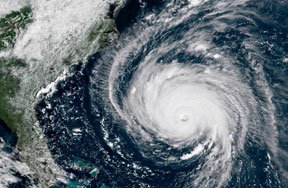Tornadoes don't really suck you into a different world like they did to Dorothy in The Wizard of Oz. They are, however, one of nature's most vicious storms. A tornado is a violently twisting column of air that extends from a thunderstorm to the ground. About 800 twisters happen across the US every year, leaving approximately 80 dead and over 1,500 injured.
What is a Tornado?
After seeing the movie Twister you probably have some misconceptions about tornadoes. A tornado is a funnel-shaped, rotating column of air that occurs when two air currents coming from opposite directions meet up. One air current will be warm, while the other is cool. When they meet up, the warm air rises and the cold air falls, causing the current to begin to spin. Tornadoes are such powerful gusts of wind that they can often sound like an on-coming trian, a jet plane or a waterfall.
Tornadoes - AKA Waterspouts
Did you know that a waterspout is a tornado over water? These usually happen along the southeast US coast, especially off southern Florida and the Keys. Waterspouts are also smaller and weaker than most tornadoes - they usually only reach wind speeds of 250 mph or more. Their path of destruction can still be over one mile wide and 50 miles long, though.
Tornadoes - The Fujita-Pearson Scale
All tornadoes are rated on a scale called the Fujita-Pearson Tornado Scale. This shouldn't be confused with the Mexican fajita. It starts at zero (the weakest) and goes to five (the strongest).
- F-0: 40-72 mph - Chimney damage, tree branches broken.
- F-1: 73-112 mph - Mobile homes pushed off foundation or overturned.
- F-2: 113-157 mph - Considerable damage, mobile homes demolished, trees uprooted.
- F-3: 158-205 mph - Roofs and walls torn down, trains overturned, cars thrown.
- F-4: 207-260 mph - Well-constructed walls leveled.
- F-5: 261-318 mph - Homes lifted off foundation and carried considerable distances, cars thrown as far as 100 meters.
Tornadoes - Common Myths
- Myth: Opening your window before a tornado will equalize pressure.
- Truth: People open windows because they think if their house pressure is equalized the damage won't be as bad. All this does is allow damaging winds to enter the house. Leave the windows closed and get to a safe place.
- Myth: The safest place to be during a tornado is in the southwest corner of the basement.
- Truth: Always go to the lowest level and stay far away from walls and windows. A small interior room like the bathroom is structurally the strongest - and don't forget to cover your head!
- Myth: Most tornadoes are the big ones you see in the news.
- Truth: Most tornadoes are about 50 - 100 feet wide, only travel about one mile and last a few minutes. The large ones rarely happen in real life - contrary to what you see in the movies.
- Myth: When on the road, it's safe to find shelter under an overpass.
- Truth: Whatever you do, don't hide under an overpass. Forget the movies. Wind currents are stronger as they are squeezed under an overpass so the speed increases. This also means flying debris could cause serious injury or death.
- Myth: Chickens are stripped of their feathers by tornadoes.
- Truth: Chickens have been found without feathers after tornadoes so it was suggested the feathers exploded off the bird from the tornado's low pressure. A more reasonable explanation is that they lost most of their feathers from stress and a tornado blew off loosened feathers.
Related Stories:
- Quiz! Test Your Natural Disaster Knowledge!
- Weather - Battling a Blizzard
- Weather - Why Wind Blows
- Weather - Earthquakes
- More Death-Defying Weather!

































